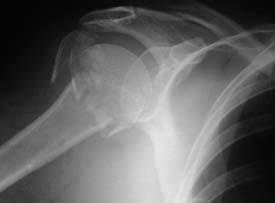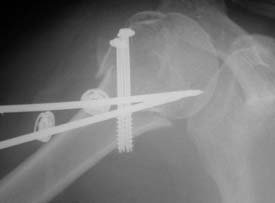Not all proximal humerus fractures amenable to percutaneous pinning
Whether doing pinning or ORIF, the goal should be anatomical reduction and stable fixation.
NEW ORLEANS — General orthopedic surgeons can quickly learn to treat proximal humerus fractures with either open reduction and internal fixation or its less invasive alternative, percutaneous pinning. Surgical treatment goals for both methods are the same: anatomic reduction, stable fixation, achieving maximal function and producing a painfree shoulder, according to Leesa M. Galatz, MD.

“A good operation is a good operation, as long you as you keep the important concepts in mind,” she said, speaking at a shoulder symposium held during the American Academy of Orthopaedic Surgeons 70th Annual Meeting, here.
Whether pinning the fracture or using open reduction internal fixation (ORIF), other points to remember include anatomic reduction of the tuberosities, as well as restoration of proximal humerus length and head height. The relationship between the head and tuberosity height should be re-established with the head approximately 5 mm to 8 mm superior to the greater tuberosity, said Galatz, who is in the department of orthopedic surgery at Washington University in St. Louis.
Percutaneous pinning is an established effective treatment. But, general orthopedists should study shoulder anatomy before attempting the technique and perform it only when completely comfortable. “Start by doing open reduction and percutaneous pinning … with easier fractures.”
Pins uncomfortable
The benefits of percutaneous pinning are preservation of proximal humerus vascularity — not only the vascular supply, but the soft tissue sleeve as well — decreased blood loss, shortened OR time and a less-obvious scar. “Rehabilitation is probably a little easier,” she said.
 --- This radiograph
shows the result of a 54-year-old woman’s trip and fall injury: a valgus
impacted four-part proximal humerus fracture.
--- This radiograph
shows the result of a 54-year-old woman’s trip and fall injury: a valgus
impacted four-part proximal humerus fracture.
COURTESY OF LEESA M.
GALATZ
Patients will find the pins to be extremely uncomfortable, but they should be left in at least four to six weeks. A pin removal procedure is always necessary, either in the OR or office. Furthermore, pinning is technically demanding and requires a compliant patient, Galatz said. “With practice, we can learn to do this.”
Only certain fracture configurations are amenable to pinning, she said. “As our understanding of these fractures and our instrumentation for doing this improves we will see expanding indications.”
According to Louis U. Bigliani, MD, member of the shoulder and elbow section of the Orthopedics Today Editorial Board, “Newer technology has made percutaneous pinning more attractive and reasonable, such as much better pins and screws and easier imaging. Its main indication is for two-part fractures.”
Indications include two-part fractures, some three- and four-part fractures. But, they all require sufficient bone quality to hold the pins, minimal or no comminution at the medial calcar, and stability that is maintainable through gentle rotation after reduction and fixation, as verified under fluoroscopy. Some valgus impacted four-part fractures may be pinned, as well.
For pinning, Galatz places patients in a 20° beach chair position, nearly supine, and uses an arm holder. Surgical neck fractures are reduced with flexion, adduction and longitudinal traction, which reduce the deforming force of the pectoralis major on the shaft. Greater tuberosity fractures displaced by the rotator cuff posteriorly and superiorly may be fixed percutaneously by engaging the bone and moving it anteriorly and inferiorly.
Reduction portal
For some cases Galatz recommends using a “reduction portal” — a small incision the size of an arthroscopic portal located approximately 5 mm posterior to the biceps tendon, about 2 cm off the anterolateral acromion. For a valgus impacted four-part, she inserts a blunt-tipped elevator or bone tamp with a small tip in the portal and then reduces the humeral head by gently tapping on the elevator with a mallet. “When there is good bone quality cannulated screws might be an option, but they are probably not the best choice in osteoporotic patients,” Bigliani said.
 --- The
patient’s fracture was treated with percutaneous pinning, shown here
immediately postoperatively. Percutaneous pinning helps maintain the blood
supply to the humeral head and reduce the risk of avascular
necrosis.
--- The
patient’s fracture was treated with percutaneous pinning, shown here
immediately postoperatively. Percutaneous pinning helps maintain the blood
supply to the humeral head and reduce the risk of avascular
necrosis.
To obtain good results with percutaneous pinning, the angle between the shaft and pin should steep to prevent pins from exiting posteriorly. Galatz uses only terminally threaded pins inserted inferior to the axillary nerve and above the deltoid insertion to protect the radial nerve as it courses around the humerus. Greater tuberosity screws should be placed through the deltoid as superiorly as possible and advanced inferiorly to avoid the axillary nerve on the deep surface of the deltoid. Widely placing pins in different directions provides more secure fixation, she said.
Postoperatively the arm is immobilized for three weeks and checked radiographically every 10 days. Pendulum and passive exercises commence at about three weeks with the remaining pins removed at six weeks or after signs of fracture healing. Active exercises begin after that. Pins may back out earlier, but nonunion and instability should not be a problem.
For your information:
- Galatz LM. Percutaneous pins versus ORIF for proximal humerus fractures: What should the general orthopaedist do? Symposium R. Presented at the American Academy of Orthopaedic Surgeons 70th Annual Meeting. Feb. 5-9, 2003. New Orleans.
